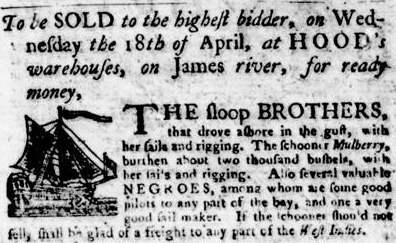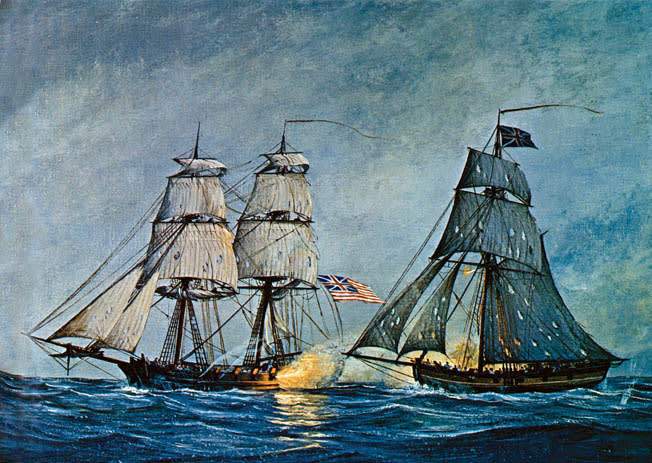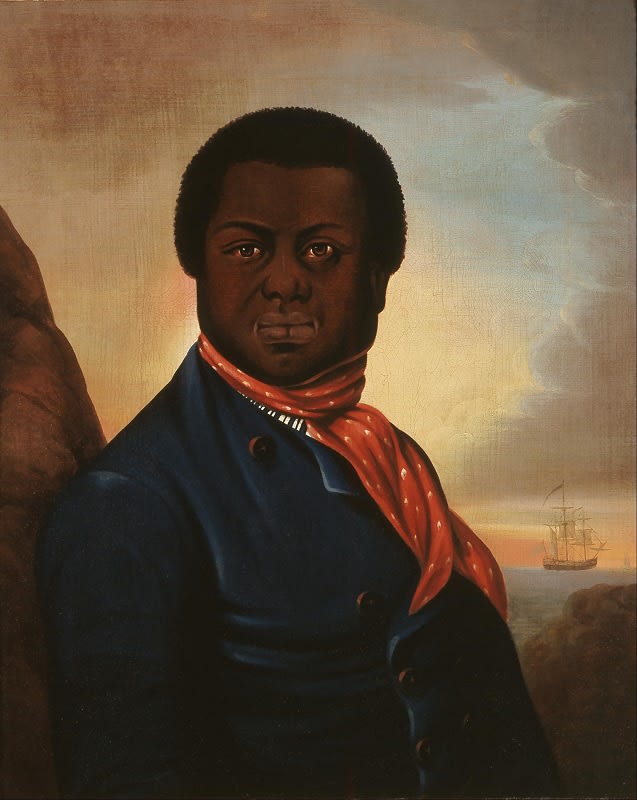How Cesar Tarrant was granted freedom through his naval service
Guests to Colonial Williamsburg discover early in their visit that at the start of the American Revolution, just over half the city’s population was enslaved. These people labored in trade shops, taverns, and the homes of Williamsburg’s well-to-do. Outside the city, enslaved people could be found working on plantations and plying Virginia’s many waterways to bring tobacco and other goods to market and back. The Virginia Gazette of the 1770s is packed with references to enslaved sailors, pilots, and even captains. Often called “skippers,” enslaved ship captains such as Minny, once owned by Joseph Pritchard of Urbanna, by necessity were “well acquainted with the bay, and all the rivers in Virginia and Maryland.” Williamsburg’s Robert Carter III owned an enslaved skipper named William Lawrence who regularly sailed the schooner Harriot between Richmond and Norfolk; enslaved mariners frequently found themselves in positions of great trust and responsibility, working out of sight of or at a great distance from their masters.
Maritime skills would be in high demand by both sides in Revolutionary Virginia, and occasionally offered the enslaved a chance at freedom. In a proclamation dated 14 November 1775, Virginia’s last Royal Governor, Lord Dunmore, declared “all indented Servants, Negroes, or others, (appertaining to Rebels,) free that are able and willing to bear Arms.” Lord Dunmore, aided by several small Royal Navy vessels, loyalist Virginians, and eventually some 800 Africans hoping to escape enslavement, for the next several months ravaged rebel plantations and settlements within easy striking distance from Virginia’s creeks and rivers. These raids were a primary cause of the Virginia Convention calling on 23 December for local Committees of Safety to acquire and deploy “so many armed vessels as they judge necessary” to protect Virginia’s patriots by water. At least fifty vessels served in the Virginia Navy during the American Revolution, crewed by approximately 1700 men of which at least 140 were of African descent.

One of the earliest vessels brought into the Virginia Navy was the schooner Patriot, a pilot boat modified to carry ten small swivel guns and twenty men. Among Patriot’s crew was Cesar, and enslaved man owned by Carter Tarrant of Hampton. Born around 1740, Cesar was trained as a river pilot, responsible for guiding vessels to safe moorings in local waters. With the outbreak of the American Revolution, Cesar was one of seven pilots (for of whom were enslaved) appointed by the Virginia Navy Board. He entered the service in 1776 or 1777 and continued there after the British surrender at Yorktown in 1781.
In October 1778, Patriot was sailing in company with the Virginia Navy ships Dragon and Tartar under the overall command of Captain Richard Taylor. When the British privateer Lord Howe entered the Chesapeake Bay, Dragon attempted to lure the enemy closer by masquerading as a merchantman. Only Patriot was quick enough to pursue when Lord Howe saw through the ruse and attempted to flee. Despite facing a larger and more heavily armed vessel, Captain Taylor ordered Patriot to ram Lord Howe, hoping to board and capture her. The British vessel fired a broadside that raked Patriot fore and aft, killing two Virginians and seriously wounding several others. When Dragon was eventually able to get close enough to join the fight, Lord Howe’s crew threw their cannon overboard to hasten their escape. Owing to his tenacity in battle, a correspondent to the Virginia Gazette voiced the hope that American historians would rank Captain Taylor alongside British naval heroes of the day. Cesar had been in the thick of things as well: not only did Captain Taylor praise the pilot’s performance in combat, but years later Patriot’s gunner, James Burk, testified that Cesar had “steered the Patriot during the whole of the action, and behaved gallantly.”

Even after the 1783 ratification of the Treaty of Paris secured American independence, Cesar remained enslaved by the Tarrant family. How and why Cesar came to fight for Virginia remains unknown, but it was apparently not as a substitute for his master; an act of the Virginia General Assembly dated 20 October 1783 declared that all enslaved persons who had served as substitutes in the American forces during the Revolution were to be emancipated. Only after another six years had passed did the General Assembly acknowledge that Cesar had “entered very early into the service of his country, and continued to pilot the armed vessels of this state during the late war; in consideration of which meritorious services it is judged expedient to purchase the freedom of the said Cesar. While Cesar himself became a free man, his wife Lucy and their three children (Sampson, Lydia, and Nancy) remained enslaved in Hampton and Norfolk.

Cesar continued working as a local pilot, eventually taking the surname Tarrant and purchasing his own land in Hampton. Cesar and other pilots of color were apparently respected enough by their white colleagues that the Virginia legislature was successfully petitioned in 1792 to allow African-American pilots to be officially licensed in the same manner as whites. The following year, Cesar purchased the freedom of his wife and ten-month-old Nancy. He died in 1797 before he could see his other children emancipated. Little is known of Sampson, who likely died enslaved. Twenty-five years after Cesar’s death, Lucy was able to purchase the freedom of Lydia, who regrettably had to leave a child of her own in bondage. In 1831, with supporting testimony from Virginia Navy veterans James Burk and William Jennings, Nancy successfully petitioned the Virginia legislature for a grant of over 2600 acres of land on the frontier owed to her father for his Revolutionary War service. Through the sale of that land, Nancy was able to purchase the freedom of her husband James and two other relatives. While the wheels of emancipation turned slowly, once hopes that Cesar would be comforted by the fact that his own wartime service led directly to at least six members of his family becoming free.
Little-known outside of Hampton (where Cesar Tarrant Middle School is named in his honor) Cesar’s is one of many often overlooked chapters in America’s enduring story.
Michael Romero has been a Historic Interpreter at Colonial Williamsburg for ten years. Since 2016, he has worked to bring eighteenth-century naval history to life. In addition to multiple posts for the CW Blog, Michael has published articles for the American Public University System, the National Association for Interpretation, and the U.S. Naval Institute. In September 2021, he presented extracts from his recently-completed master’s thesis at a symposium hosted by the U.S. Naval Academy.
Editor's note: This post was originally published in January 2020 and has been updated to reflect new research and ensure accuracy.
Further Reading
- Bilal, Kolby. “Black Pilots, Patriots, and Pirates: African-American Participation in the Virginia State and British Navies During the Revolutionary War in Virginia”. ProQuest Dissertations Publishing, 2000.
- Bolster, W. Jeffrey. Black Jacks: African-American Seamen in the Age of Sail. Cambridge: Harvard University Press, 1997.
- Eve - Lord Dunmore's Proclamation. Museum of the American Revolution. https://www.amrevmuseum.org/virtualexhibits/finding-freedom/pages/eve-lord-dunmore-s-proclamation.
- Hays, Alex. “America’s First Black Sailors.” The Sextant. Naval History and Heritage Command. https://ussnautilus.org/americas-first-black-sailors-2/
- Long, Charles Thomas. "Green Water Revolution: The War for American Independence on the Waters of the Southern Chesapeake Theater." PhD diss., The George Washington University, 2005.
- Stewart, Robert Armistead. The History of Virginia's Navy of the Revolution. Richmond: Mitchell & Hotchkiss, 1934.
Colonial Williamsburg is the largest living history museum in the world. Witness history brought to life on the charming streets of the colonial capital and explore our newly expanded and updated Art Museums of Colonial Williamsburg, featuring the nation’s premier folk art collection, plus the best in British and American fine and decorative arts from 1670–1840. Check out sales and special offers and our Official Colonial Williamsburg Hotels to plan your visit.
Learn More
Related Events
-
Conversation: Meet a Nation Builder
Find a Nation Builder, a significant figure of 18th-century Williamsburg, around Palace Green for some informal conversation.
Open to the Public
-
Special Event: Juneteenth Sunrise Service
Join us at the Compton Oak on Market Square to commemorate Juneteenth with a Sunrise Service. Special keynote address by world-renowned poet and writer Nikki Giovanni.
Open to the Public
-
Performance: God is My Rock
Gowan Pamphlet, an enslaved man and popular local preacher, offers his perspective on slavery, religion, and freedom.
Art Museums Admission
